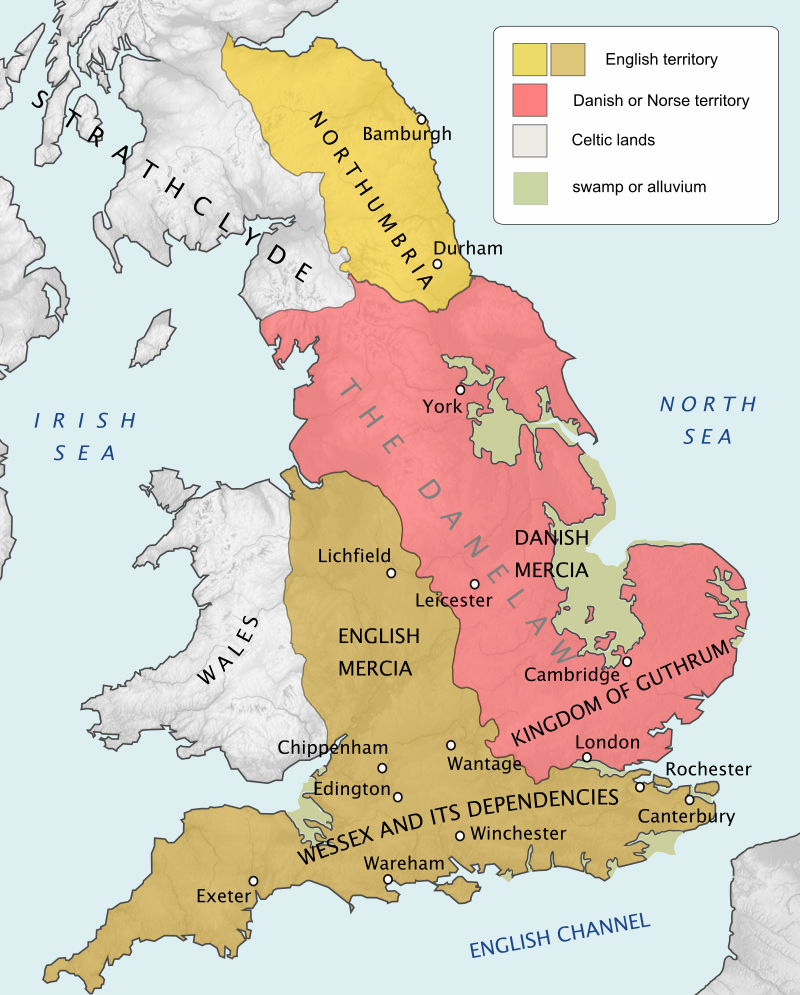by Paul Braterman

The Vikings started out as raiders, but then, in the way of these things, ended up as rulers, and their influence stretched from Greenland to what is now Russia. They first enter English history in 793, with the sacking of the Monastery of Lindisfarne. By the late 9th century, they were colonising Iceland, and serving as mercenaries to the Emperor of Byzantium. In 862, Vikings under Rurik established themselves in Novgorod, forming the nucleus of what would become Kyivan Rus. In 885, Vikings besieged Paris, and although they were beaten back settled in what is now Normandy (Norman, Northmen). In 865, the Viking Great Heathen Army arrived in England, and a year later, under Ivar the Boneless, captured York, which would remain their capital in England until the defeat of Eric Bloodaxe in at 954.
The Vikings’ goal was to establish themselves as rulers over Anglo-Saxon England, divided at that time into the four kingdoms of Northumbria, East Anglia, Mercia, and Wessex, and in this they were almost successful. After establishing their kingdom in York, they swept south, taking control of East Anglia and killing its king, who had earlier provided them with horses. They then spend the next five years consolidating their hold over what had been the most powerful of the Saxon kingdoms, Mercia, stretching from the Thames to the Humber, whose king took refuge in Paris. The Anglo-Saxon Chronicle tells us that in 873-44, a date that will prove significant for us, the army spend the winter in Repton, then a town of some importance. It then divided, one part going north to consolidate control over York, while the other swept south through Mercia into Wessex, which they effectively overran over the next two years.

The then King of Wessex, Alfred, was not obviously born to kingship, but the throne had passed to him after the death of his brothers. He was forced to take refuge in the Somerset marshes, where according to legend he burnt the cakes while busy contemplating his next move. Despite these reverses, he was able to raise an army from Somerset, Wiltshire, and the part of Hampshire not directly under Danish control. There he developed the strategy of building strategically located burhs, some taking advantage of fortifications surviving from Roman times, where the nearby Saxons would gather and organise if attacked. Alfred’s forces inflicted a major defeat on the Danes at the Battle of Edington, after which their leader, Guthrum. made peace with Wessex. Guthrum and Alfred agreed terms of trade and established a boundary to the Danish domain (the Danelaw) stretching roughly from London to Chester, while Guthrum himself agreed to be baptised, with Arthur acting as his godfather. The ruler of Mercia accepted Alfred as a superior and married his daughter, and Alfred assumed the title of King of the Anglo-Saxons. The Danish forces then dispersed. Guthrum himself became king of East Anglia, and some Danish forces returned to the Continent, while others remained in the Danelaw, which was not finally brought under English domination until 954.
English schoolbooks describe the entire episode as a great victory, and so it was from the point of view of Wessex, with the rival kingdoms of East Anglia and Mercia conveniently eliminated. The Danes, however, had managed to gain control of almost the whole of northern and eastern England, where they would retain a major presence for 70 years.

Alfred was probably the most able ruler that England has ever had. He rebuilt London, which had been destroyed in the wars. Realising that the existing militia system responded to slowly to the Danes’ hit-and-run tactics, he organised a standing army and navy paid for by taxation, and located burhs strategically where bridges crossed major rivers. Among his other accomplishments, he established schools and required the children of nobles to be educated, codified laws, and had key documents translated into the English of the time, which became the language of instruction.
There is a large defensive ditch enclosing the Saxon church of St Wystan in Repton, where the Vikings had overwintered. Within the enclosed area is a mound, containing over 250 skeletons, mostly of men between the ages of seventeen and forty-five. This collective grave had been lined with clay at the bottom, suggesting a single mass burial event. There are a few coins, all dated to the period 872-4. Other, smaller graves nearby show Scandinavian-style burial practices and grave goods, including a silver amulet Hammer of Thor, so it would be natural to suppose that we are looking at burials connected with the Viking army. It should be easy enough to test this hypothesis, by radiocarbon dating of the collagen in the bones, but the results of this were quite surprising. While some of the radiocarbon age estimates included the relevant date, others appeared to be about a hundred years older. It was of course possible that skeletons already in the ground at that point had been reburied, but that does seem rather unlikely.
 So was there anything about the Vikings that could make their skeletons seem older than they actually were? Yes; they ate a lot of fish.
So was there anything about the Vikings that could make their skeletons seem older than they actually were? Yes; they ate a lot of fish.
L: St Wistan, Repton. The tower and spire are later (1340) addition. Image from Staffordshire Live, March 2018, celebrating the work reported here.
To understand why that could be making a difference, we need to look closely at how radiocarbon dating works. Most dating methods depend on long-lived radioactive nuclei that date back to the formation of the earth. Carbon-14, however, has a half-life of a mere 5,700 years. The only reason why there is any at all is that it is continually replenished by cosmic ray bombardment of nitrogen-14 in the upper atmosphere. This new carbon-14 is then circulated through the atmosphere, and taken up by plants and hence by animals. When an organism dies, it is no longer taking part in this circulation and its carbon-14 is no longer replenished as it decays. Thus the radiocarbon age of once-living material would be expected to correspond roughly to the time since death.
However, we’ve known for a long time that if for any reason an organism gets its carbon from a pool that is isolated from the general circulation, radiocarbon dating can be spectacularly wrong. 60 years ago, a freshwater mussel collected live from a tributary of the Mississippi gave a radiocarbon age of 2300 years. The river at that point was flowing over a limestone (calcium carbonate) bed, and if around one quarter of the carbon that ended up in the growing mollusc came from that source, that would explain the result, since the limestone being ancient contains no radiocarbon at all. Less spectacularly, marine environments are known to give anomalously old apparent ages, because of the time it takes for atmospheric carbon dioxide to diffuse into the oceans. The effect is even bigger for river fish, because of the influence of dissolving limestone. As a demonstration, a group of German and Danish researchers tried cooking fish in a clay pot over a wood fire, and then dated the organic residues. The apparent age was 700 years. And you are what you eat; the radiocarbon in your bone collagen will reflect the radiocarbon in your diet at the time the collagen was formed.
So do Viking eating habits explain the anomalous dates at Repton? In order to check this, we need to do two things. We need to show the Vikings really did eat a lot of fish, and we need to show that doing so really does make the expected difference to apparent radiocarbon age. Fortunately, a study of the fate of the Viking settlement in Greenland gives us the answers to both these questions.
The Vikings first settled in Greenland under the leadership of Eric the Red in 985 CE, after he had been banished from Norway for manslaughter. The settlement grew to a population of around 5000, but was abandoned in the mid-15th century. One possible explanation is local climate change. 985 was during the Mediaeval Warm Period, which brought mild climates in the North Atlantic basin, but by 1450 this was giving way to the Little Ice Age. If this colder climate had been responsible for crop failures, this may be reflected in the settlers eating more fish. Moreover, the skeletons in Iceland also gave anomalous radiocarbon ages, with some apparently predating the original settlement.

We can study ancient diets by looking at a stable minor isotope of carbon, carbon-13, present in around 1.1% abundance. Students are often told that different isotopes have different masses, but identical chemistry. This is not quite true. For reasons well understood in terms of quantum mechanics [1], carbon-13 is slightly less reactive than carbon-12, and is selected against to different extents by different kinds of plant. This eventually results in small but measurable changes in human collagen carbon-13 abundance, depending on diet. The amount of carbon-13 can now be measured to high accuracy using mass spectrometry, and is larger in fish eating populations, such as British Columbia First Nations, than with those on a low fish diet such as inland rural populations without major rivers.
The carbon-13 and carbon-14 data for the Greenland Vikings should therefore be examined together. It was found from the carbon-13 data that, as hypothesised, fish became more and more important in their diet at later dates. It was also possible to estimate how anomalous the carbon-14 data were for the skeletons, by comparing them with their woollen grave clothes (sheep do not eat fish). And indeed, the more important fish had been in any individual’s diet, the greater the disparity between apparent and true age. This is in fact a quantitative relationship, so that after measuring the carbon-13 content of a skeleton, we can calculate the expected radiocarbon age anomaly, and correct for this. When this is done, we find as expected that the true age of death of all the skeletons was late ninth century. Notice that there is no circular reasoning involved here. The relationship between carbon-13 and fish eating was established directly from observations of populations with known differences in diet. The reality of carbon-14 anomalies in dating the skeletons of fisheaters at Repton was established using actual known dates of death from Greenland. It was only after these relationships have been established, that it was possible to calculate the appropriate corrections to the Repton data.
 The Institute for Creation Research (ICR) reported on this study, shortly after it was published, under the clickbait title Viking Bones Contradict Carbon-14 Assumptions. Their report goes on to say, quite correctly, that when it comes to radiocarbon dating one size does not fit all, and from this draws the inference that scientific evidence (radiocarbon dating) is intrinsically less reliable than eyewitness testimony (the Anglo-Saxon Chronicle). This of course is exactly back to front; we regard the Anglo-Saxon Chronicle is pretty reliable because its account matches the archaeological findings. The ICR article’s author, James Johnson, has a law degree, and arguments based on the correction of scientific errors seem to have a particular appeal to lawyers, who treat the science as they would a witness who had changed their story under cross-examination. This shows total misunderstanding of what is really going on, and it is deplorable that lawyers (and juries) regard eyewitness accounts as more reliable than forensic evidence. There is the further irony that the eyewitness evidence regarding age to which Johnson is appealing is the alleged testimony of the Creator as laid out in Genesis. This, technically, is hearsay evidence, and as any lawyer should know is at best only as reliable as the process of reporting.
The Institute for Creation Research (ICR) reported on this study, shortly after it was published, under the clickbait title Viking Bones Contradict Carbon-14 Assumptions. Their report goes on to say, quite correctly, that when it comes to radiocarbon dating one size does not fit all, and from this draws the inference that scientific evidence (radiocarbon dating) is intrinsically less reliable than eyewitness testimony (the Anglo-Saxon Chronicle). This of course is exactly back to front; we regard the Anglo-Saxon Chronicle is pretty reliable because its account matches the archaeological findings. The ICR article’s author, James Johnson, has a law degree, and arguments based on the correction of scientific errors seem to have a particular appeal to lawyers, who treat the science as they would a witness who had changed their story under cross-examination. This shows total misunderstanding of what is really going on, and it is deplorable that lawyers (and juries) regard eyewitness accounts as more reliable than forensic evidence. There is the further irony that the eyewitness evidence regarding age to which Johnson is appealing is the alleged testimony of the Creator as laid out in Genesis. This, technically, is hearsay evidence, and as any lawyer should know is at best only as reliable as the process of reporting.
What we have here, contrary to ICR’s claim, is an example of science at its best. We had an initial hypothesis that the skeletons were Viking, strongly supported by grave goods and the known presence of the Heathen Great Army in Repton. But there was an anomaly, namely the radiocarbon dating of the bones. A suggested resolution involved the effect of diet on apparent age, but without further confirmatory evidence this will be a highly unsatisfactory ad hoc solution. However, the carbon-13 evidence allows us, using calibration obtained from a separate set of data (Greenland), to apply the appropriate correction, and the anomaly then disappears.
The story has important implications for studies of England and presumably elsewhere during the Viking period. There is long-standing puzzlement among archaeologists about the apparent lack of Viking skeletons, and it now seems that this might be resolved by re-dating skeletons thought to be pre-Viking, applying the appropriate correction for diet. It is also a splendid example of science in action. Hypothesis (that we are looking at skeletons from the Viking Great Army), anomaly (mismatch of measured dates), subsidiary hypothesis (the effect of diet) proposed to resolve the anomaly, and independent support for that subsidiary hypothesis, without which we would have had to suspect special pleading.
As might be expected, radiocarbon dating anomalies play a special role in creationist arguments. We have seen how ICR put a creationist spin on this anomaly. That was back in 2018, when the story was fresh. For reasons I do not understand, Chick Tracts, who describe their output as “Cartoon Gospel Stories That People Love To Read”, featured the story in their most recent product, March 2023, contrasting the unreliability of scientific evidence with the unquestionable weight of eyewitness testimony in the Gospel. Chick Tracts’ most famous offering being Big Daddy?, in which a godless science teacher is converted to Christianity by an evolution-rejecting student, who uses a number of arguments that will be very familiar to anyone acquainted with a creationist literature. Moreover, the science teacher cannot explain what holds atomic nuclei together, until the student tells him that all things are held together by Christ. The current version of Big Daddy? has the student using arguments long since refuted, telling us that Lucy was a chimpanzee, that vestigial organs are not really vestigial because they have vestigial functions, that the use of index fossils involves arguing in a circle, and that polystrate fossil trees prove the reality of Noah’s flood. The original (1972) version was to my mind far superior, invoking instead actual dating anomalies (including the mollusc we met earlier), correctly criticising the then-popular view that the problem of the origin of life had been solved (it hadn’t, and it hasn’t), and pointing out the differences between evolution driven by chance, evolution as progress, and theistic evolution. As the 1972 version shows, the author Jack Chick (1924 – 2016) was at that time powerfully influenced by the misguided but more or less intellectually reputable creationists around Henry Morris, co-author of The Genesis Flood, while towards the end of his life, as shown [2] by the tract In The Beginning, Chick fell under the influence of the extraordinary Kent Hovind, who maintains that income tax is unconstitutional. Hovind has also claimed, among other things, that the US government is using implanted microchips to track people, that “FEMA is already developing detention camps to put prisoners in when they do not agree with the New World Order”, and that 666 in barcodes fulfils a prophecy in the book of Revelation. In The Beginning includes at least two arguments (the canopy, the Glen Rose footprints) that Creation Ministries International has listed among the arguments that creationists should no longer use.
The 1972 version of Big Daddy? thanks Dr Bolton Davidheiser, PhD Johns Hopkins, who wrote genuine scientific papers (about sex determination in beetles) before becoming involved in creationism, cites Melvin A. Cook, Professor of Metallurgy at Utah, and correctly states the findings of several scientific papers, although it misinterprets the implications. The 2000 version refers only to creationist sources, apart from one journal reference (New Scientist September 6, 1999) that does not exist.
Do such changes matter in an intellectually negligible comic strip? Yes, when the world is as it now is, and when the comic strip series in question has sold over 1 billion items.

1] Zero-point energy has the effect of causing lighter isotopes to prefer environments in which they are more loosely bound, including the transition states involved in chemical reactions.
2] Private communication from Kurt Kuersteiner, who was generous with information even though aware that I totally disagree with him. Kurt maintains an informative website dedicated to Jack Chick’s work.
I thank Glenn Branch, of the National Center for Science Education, for information and suggestions.
